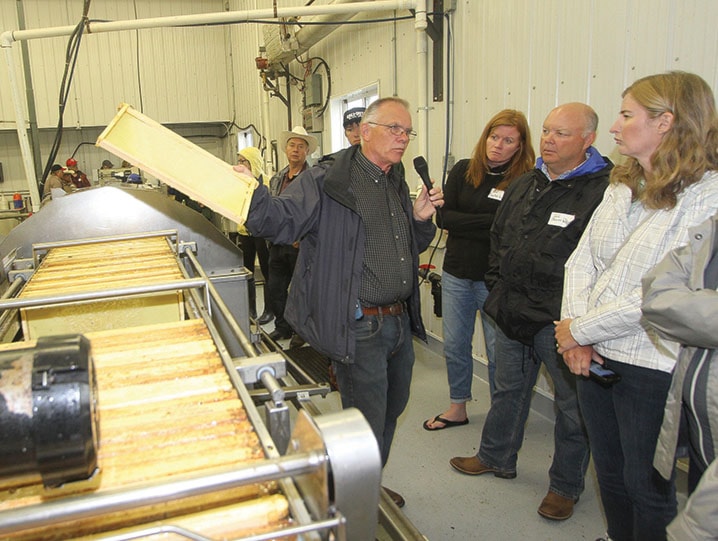Canadian honey producers can commiserate with Gucci, Prada and Rolex.
They are all being plagued by cheap foreign-made copycat products.
In recent years, a world honey glut and a growing supply of imported product — much of it of questionable quality — has halved honey prices from $2.30 a pound in 2014-15 to about $1.20 today.
At that price, the industry continues running, but only just, says Kevin Nixon, of the Innisfail-area’s family run Nixon Honey. Nixon is also chairman of the Canadian Honey Council, the industry’s national body.
“In the current situation, we’re hoping to get by and cover our bills,” says Kevin, who lives and works on the family farm a few kilometres east of Innisfail with parents Cheryl and Bryan and brother Craig.
The Nixon operation oversees 8,000 hives at 200 sites and produces up to one million pounds (454,000 kg) of honey every year, about three-quarters of it for export to the U.S. and, to a smaller extent, Japan.
Much of the foreign honey is coming from Thailand, Myanmar, Taiwan, Ukraine and Vietnam, says Kevin.
Before that, cheap Chinese honey flooded the market and the U.S. imposed a 212 per cent tariff that stemmed the flood for a time and prices improved.
But it wasn’t long before loopholes were found and the industry is now seeing Chinese honey re-routed through other countries for export.
Some countries are exporting more honey than they have the capacity to produce, a sure give-away.
The problem isn’t only the quantity arriving in North American ports, it’s the quality. Much of the honey is adulterated, mixed with other forms of sugar to bring costs down.
“In the U.S., they’ve done a lot of testing and they’re seeing honey coming in that is not actually honey. It’s adulterated honey. Sometimes, it’s being mixed with sugars and rice syrups and such. It’s simply not honey.
“It’s deceiving to the consumer when the consumer thinks they’re buying honey, and it’s killing the industry.”
Since tariffs are unlikely to provide a long-term solution, Canadian beekeepers want to see the government step up and test more imported honey to weed out the low-cost fakes that are distorting the market.
“We need to work with government to try and get this looked at and taken care of because it’s a huge blow to us.”
Another file Nixon is working on as part of the national organization is the issue of Temporary Foreign Workers, a program that many beekeeping businesses count on for labour help.
“The challenge is it’s a seasonal job so we can’t offer full-time career-type employment,” he says. “We don’t get applications from people looking to work here.
“It’s the same across the industry. It’s just a fact of life.”
Changes by the federal government to the Temporary Foreign Worker program set caps on how many months workers could be employed in Canada since April 2011. Once they accumulate 48 months of work, they are not allowed back in the country for another four years.
Two of Nixon’s more experienced workers — one with 10 years of service and the other with six — are close to that threshold and he would hate to lose them. Other beekeepers risk losing bigger numbers of their best workers.
The Canadian Honey Council is lobbying for changes to help the industry.
Beekeepers are also playing close attention to a mite that ravaged bee populations a number of years ago before an improved pesticide was employed.
The bee industry is doing well now, but the mild winters and early springs of the past couple of years have given mite populations a longer reproduction cycle, which means greater numbers of the pests.
“We have to keep a close eye on that to keep them under control,” he says.
